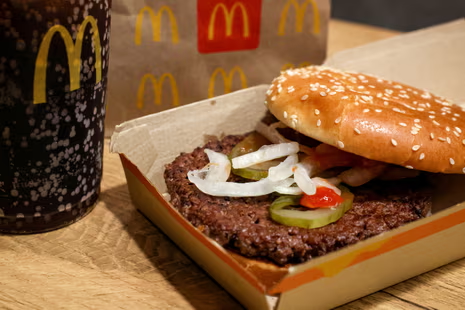An E. coli outbreak linked to McDonald’s products has sent shockwaves through the U.S., leaving one person dead and 49 others ill. Among those affected, 10 individuals have been hospitalized, with officials urging swift action to address the outbreak. The Centers for Disease Control and Prevention (CDC) and McDonald’s have responded decisively, but the situation raises critical concerns about food safety and public health.
What Happened? Understanding the E. Coli Outbreak

The outbreak has been traced to certain McDonald’s menu items, including the Quarter Pounder and slivered onions, which are suspected to be contaminated with a strain of E. coli known as Shiga toxin-producing E. coli (STEC). This strain, also referred to as Escherichia coli O157, is notorious for causing severe foodborne illnesses.
The Scope of the Outbreak
- Total Cases: 49 confirmed illnesses across multiple states.
- Hospitalizations: 10 individuals have required medical treatment.
- Fatalities: One person has tragically lost their life.
- Affected States: Impacted regions include Colorado, Kansas, Utah, Wyoming, and portions of Idaho, Iowa, Missouri, Montana, Nebraska, Nevada, New Mexico, and Oklahoma.
This outbreak has prompted McDonald’s to temporarily remove Quarter Pounders and slivered onions from menus in the affected areas.
What Is Shiga Toxin-Producing E. Coli (STEC)?
E. coli is a broad family of bacteria, and while most strains are harmless, certain types, like STEC, can cause severe health issues. The World Health Organization (WHO) classifies STEC as a leading cause of foodborne illness globally.
Symptoms of STEC Infection
The CDC warns that individuals infected with STEC may experience:
- Severe stomach cramps.
- Diarrhea, often bloody.
- Vomiting.
Symptoms typically appear 3 to 4 days after consuming contaminated food or water and can last up to a week.
Potential Complications
In severe cases, STEC can lead to hemolytic uremic syndrome (HUS), a condition that affects the kidneys and may require hospitalization. Symptoms of HUS include:
- Extreme fatigue.
- Decreased urination.
- Pale skin.
If untreated, HUS can result in long-term kidney damage or death.
How McDonald’s and Officials Are Responding
McDonald’s has acted swiftly to address the situation, prioritizing customer safety while working closely with health authorities.
McDonald’s Statement

Cesar Piña, McDonald’s North America Chief Supply Chain Officer, emphasized the company’s commitment to safety:
- Product Recall: All slivered onions from the suspected supplier have been removed from the affected areas.
- Menu Adjustments: The Quarter Pounder has been temporarily discontinued in impacted regions.
- Partnership with CDC: McDonald’s is collaborating with the CDC to monitor the outbreak and provide updates.
CDC’s Role
The CDC has issued a public advisory to raise awareness of the outbreak and shared guidelines for recognizing symptoms and seeking medical attention.
How to Protect Yourself During an E. Coli Outbreak
Foodborne illnesses can be daunting, but taking a few precautions can significantly reduce your risk.
Recognize the Symptoms

If you experience any of the following, seek medical help immediately:
- Diarrhea lasting more than three days or accompanied by fever above 102°F.
- Bloody diarrhea.
- Persistent vomiting that prevents you from keeping liquids down.
- Signs of dehydration, such as dizziness, dry mouth, or infrequent urination.
Practice Food Safety at Home
Even outside of this outbreak, food safety is critical:
- Wash produce thoroughly.
- Cook meat to recommended temperatures (160°F for ground beef).
- Avoid cross-contamination by using separate cutting boards for raw meat and other foods.
Stay Informed
Keep up with updates from the CDC and local health departments regarding the outbreak’s status and additional food recalls.
What Does This Mean for McDonald’s Customers?
McDonald’s has assured customers that all other menu items, including Cheeseburgers, Big Macs, and McDoubles, are unaffected and safe to consume. The company is working diligently to replenish safe supplies for Quarter Pounders and onions.
For now, customers in affected areas should avoid ordering menu items that may contain the implicated ingredients until the investigation concludes.
The Bigger Picture: Foodborne Illnesses in the U.S.
E. coli outbreaks like this one highlight the importance of stringent food safety measures. According to the CDC:
- Approximately 48 million Americans get sick from foodborne illnesses annually.
- Of these, around 3,000 deaths occur each year.
The Role of Suppliers and Restaurants
Outbreaks often begin at the supplier level, where contamination can spread quickly if not detected early. Restaurants must maintain rigorous quality control processes to prevent contaminated products from reaching customers.
Lessons Learned from the Outbreak

This E. coli outbreak underscores the importance of vigilance at every stage of the food supply chain, from production to preparation. For consumers, it serves as a reminder to prioritize food safety and seek medical attention promptly if symptoms arise.
Moving Forward
As McDonald’s works to restore its full menu and ensure product safety, customers can take solace in the company’s proactive response. With increased collaboration between public health agencies and food providers, such outbreaks can be mitigated more effectively in the future.
Conclusion: Stay Informed and Stay Safe
The recent E. coli outbreak linked to McDonald’s products is a sobering reminder of how quickly foodborne illnesses can escalate. While one life has been tragically lost and many others affected, the swift actions of health officials and McDonald’s demonstrate the critical importance of transparency and safety protocols.
As consumers, staying informed and recognizing symptoms can make all the difference. Let this incident serve as a call to action for both individuals and the food industry to prioritize safety at every level. By doing so, we can help prevent future outbreaks and protect public health.


